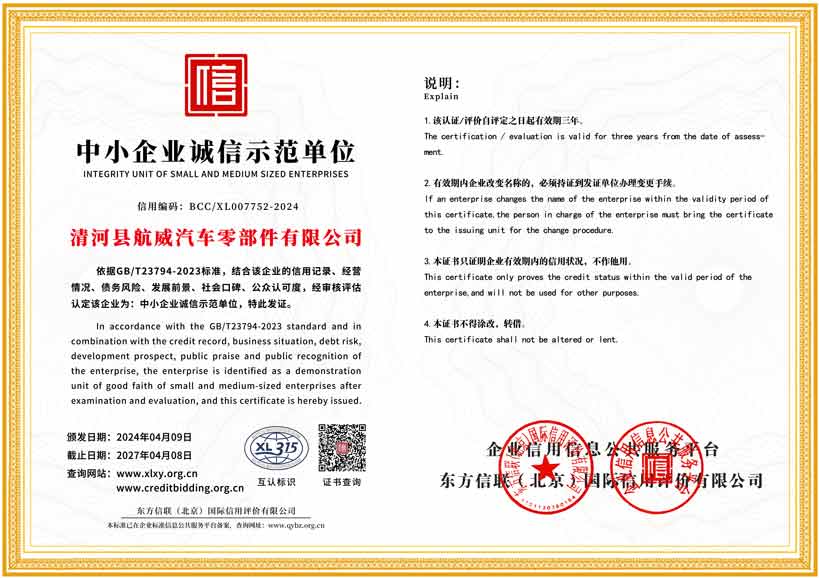transmission gear shift cable
Understanding Transmission Gear Shift Cables Functions and Maintenance
The transmission gear shift cable is a crucial component in modern vehicles, playing a significant role in the seamless operation of the transmission system. This cable connects the gear shift lever in the cabin to the transmission itself, allowing drivers to change gears smoothly and efficiently. Understanding the functionality, signs of wear, and maintenance of the gear shift cable can enhance your driving experience and contribute to the longevity of your vehicle.
Functionality of the Gear Shift Cable
When a driver moves the gear shift lever, the gear shift cable transmits this movement to the transmission via a series of linkages. This action helps to engage and disengage gears, enabling the vehicle to accelerate, decelerate, and reverse as needed. The cable is typically made from a durable material, which is designed to withstand significant tension and frequent movement.
In automatic vehicles, the gear shift cable works in conjunction with the electronic control module, which determines when to shift based on various inputs such as speed, engine load, and driver behavior. In manual vehicles, the cable plays a more direct role, requiring the driver to physically change gears through a mechanical process.
Signs of a Failing Gear Shift Cable
As with any mechanical component, the transmission gear shift cable can wear out over time. Identifying signs of a failing cable early can save you from more extensive repairs in the future. Common symptoms include
1. Difficulty Shifting Gears If you experience resistance or feel like the gear lever is stuck, it could indicate a problem with the cable. This might be due to fraying, stretching, or other forms of damage.
2. Unusual Noises Grinding, clunking, or other abnormal noises when shifting gear can signal issues not only with the cable but also with the transmission itself.
3. Shifting Out of Gear If your vehicle unexpectedly pops out of gear or fails to stay in the selected gear, the cable may not be functioning correctly.
transmission gear shift cable

4. Warning Lights Many modern vehicles are equipped with sensors that can alert the driver to transmission issues. If you see a warning light related to the transmission, it’s important to get it checked immediately.
Maintenance Tips
Regular maintenance of your gear shift cable can prevent many issues. Here are some essential tips to keep in mind
1. Routine Inspections Include the gear shift cable in your regular vehicle maintenance checks. Look for signs of fraying, rust, or other damage.
2. Keep It Lubricated Proper lubrication allows for smooth movement and reduces wear on the cable. Check the manufacturer's recommendations for the best lubricant to use.
3. Monitor Performance Pay attention to how your vehicle shifts gears. Sudden changes in performance can indicate that it’s time for a closer inspection of the cable.
4. Replace When Necessary If you notice any of the warning signs mentioned earlier, it’s important to replace the gear shift cable as soon as possible. Delaying a repair can lead to more significant and expensive issues down the line.
Conclusion
The transmission gear shift cable may seem like a small component, but its role in vehicle operation is undeniably important. By understanding how it works, recognizing the signs of wear, and adhering to basic maintenance guidelines, drivers can ensure a safer and more enjoyable driving experience. Regular attention to this often-overlooked part can prolong the life of your vehicle's transmission and prevent costly repairs, ultimately contributing to better performance and reliability. Always consult a professional mechanic if you suspect any issues with your gear shift cable, as their expertise can help diagnose and fix problems effectively.
-
Workings of Clutch Pipe and Hose SystemsNewsJun.04,2025
-
The Inner Workings of Hand Brake Cable SystemsNewsJun.04,2025
-
The Secrets of Throttle and Accelerator CablesNewsJun.04,2025
-
The Hidden Lifeline of Your Transmission Gear Shift CablesNewsJun.04,2025
-
Demystifying Gear Cables and Shift LinkagesNewsJun.04,2025
-
Decoding Clutch Line Systems A Comprehensive GuideNewsJun.04,2025
